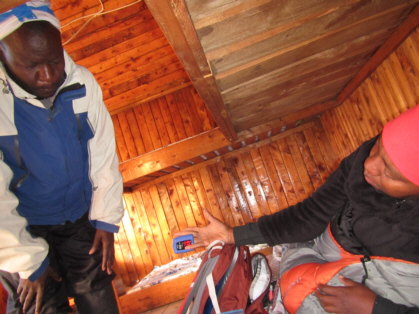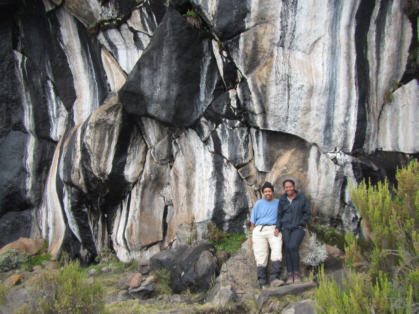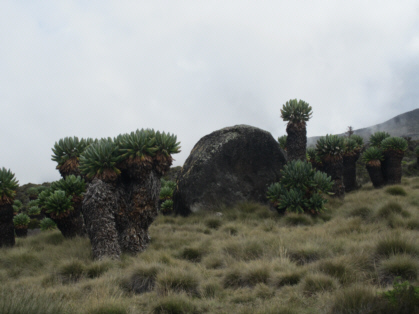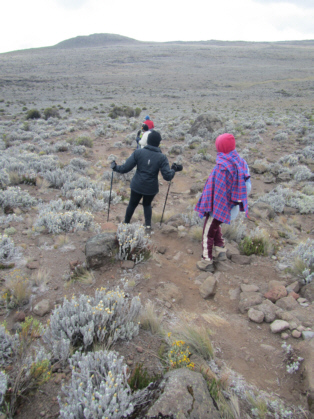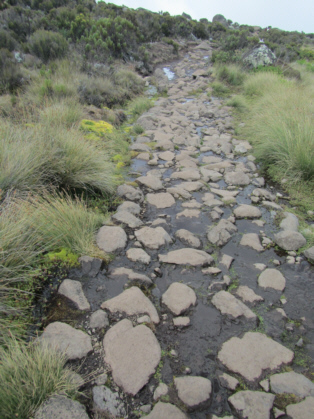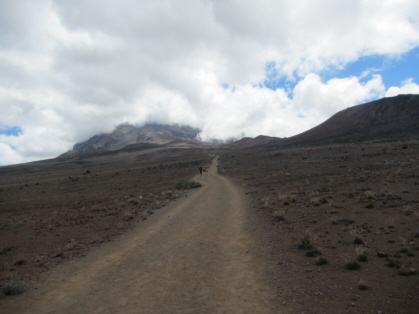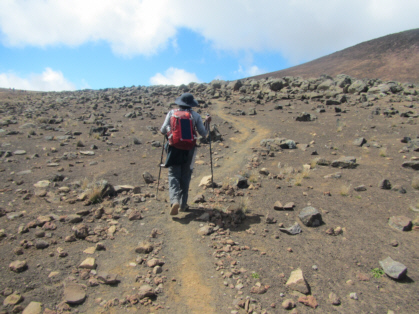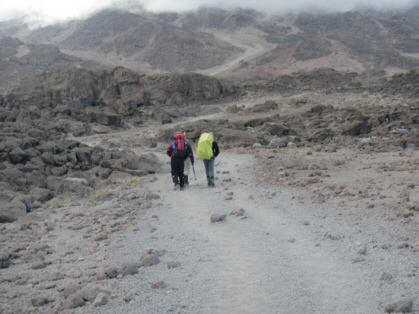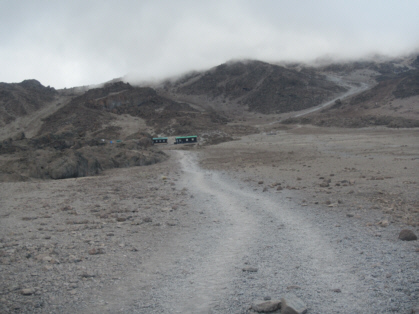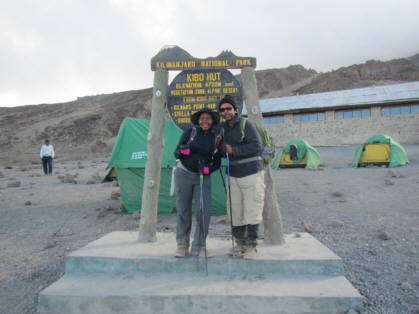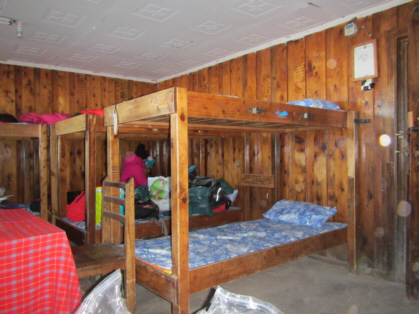Day 3:
The morning of Day 3, Traci and I said goodbye to the rest of the group who received their wake-up knock at 6:30. They were doing the 5-day version of the Marangu Route. During my research of the climb, over and over I read that the 5-day trek is not recommended because it does not provide enough time for your body to acclimatize. Therefore, a few weeks before our trip, I contacted our trip organizer, Marie Frances, and requested that Traci and I be changed to the 6-day Marangu Route climb. She was able to make the switch for an additional $300.
When the group left, it seemed like Traci and I were the only ones left in the camp. We ended up having a hut to ourselves for the remainder of our time at Horombo and at the next camp - Kibo.
Every day that we were above 12,000 feet, there was a mandatory health check. A guide would ask what type of symptoms we were experiencing and then put a meter on our finger to measure our blood oxygen level and heart rate. Our blood oxygen levels were fine; however, I was surprised to see that my resting heart rate was 120 beat per minute! It is normally in the 70’s. The guide questioned it but said it was okay. He was more concerned about how low Traci's heart rate was. Hers was 58. I guess all the running she does has made her heart very efficient even at altitude. In the end, he said we were both okay to continue. I was still slightly concerned about my elevated resting heart rate. If it was that high when I was resting, how high did it go when we were walking uphill? My resting heart rate was around 120 for the remainder of our time at altitude.
mandatory daily health check when above 12,000 feet
The rest of our day consisted of an acclimatization hike up to some cool-looking lava rocks called Zebra Rocks and then back down to Horombo. The idea is to “climb high and sleep low” to help your body adjust to the altitude. We also got a chance to check out some of the unusual plants that grow at this elevation such as the giant lobelia.
Acclimatization Hike
There were a few steep sections during our trek but our guides encouraged us to go “pole, pole” (pronounced polay, polay). This means slowly in Swahili. Our guides were right. I went slowly up the inclines and did not have the exhaustion I felt the day before. The round-trip time for our excursion was approximately three hours.
We had a nice lunch after our acclimatization hike. We really enjoyed the corn and potato soup. I was happy that I could eat something that day. My appetite was waning. I could tolerate savory things such as the soup but I had no desire for anything sweet.
Traci and I were the only ones in the mess hall. We discovered a disadvantage of not having other people around – rodents! The rodents stayed hidden while there were many people in the mess hall. Now that there were just the two of us, the rodents were scurrying under the tables to snatch crumbs. Yuck!
After dinner, we received some unsettling news. One of our guides told us that they had received a call on the radio indicating that someone in our group had become seriously ill from the altitude at base camp (Kibo). Our guide did not know who it was. He only knew it was one of the four males of the group. Our guide set off on foot in the dark to assist the other guides who were several hours away bringing the victim down to our camp.
Before I turned in for the night, I bundled up and went outside in the crisp mountain air with my binoculars to take a look at the incredible sky. It was covered with so many stars. The moon, Venus, and Jupiter all shined brightly as well. It was an amazing end to an interesting day.
Day 4:
Our wake-up knock at the door came at 7:30 AM. We had breakfast and got prepared for a long day. Traci ran into the guy who had become ill. She said he seemed to be doing okay.
We finally hit the trail by 9 AM. We would be crossing the alpine desert. Even though it was quite barren, we enjoyed the views. It was sunny for most of the trek. This allowed Traci to use the solar panel attached to her daypack to charge our mobile devices. In the distance we could see the peak of Kilimanjaro. It would become obscured by clouds from time to time. Traci and I stopped several times to take pictures.
During our trek, we ran into some of our group members. Since they were doing the five-day climb, they were now on their way back down the mountain. We were excited to see each other. They briefly shared their stories of how difficult the climb was. Not everyone made it to Uhuru Peak but most made it to Gilman’s Point which was enough to earn them a certificate for climbing Kilimanjaro.
We stopped at a picnic area to eat the box lunch that was provided and continued our trek across the desert. The last 3.5-hours were very tough for me. That feeling of fatigue had returned. I had slowed to a snail’s pace. Traci seemed to be doing just fine. We came across a "Last water point" sign. We did not do anything there other than take a picture; however, this is a good time to note that the porters do not carry water up the mountain. Instead, they collect the water from mountain streams and boil it. They fill our water bottles and CamelBaks each morning. We would then add purification tablets as an extra safety measure.
Crossing the Alpine Desert
We pushed on past the last water point. The vast landscape played tricks on our perception. We could see that we were approaching our next lodging (Kibo Hut). It came as a shock to Traci and me when our guides told us that we were more than two hours away from it. They were right. During that time, I kept feeling as if I had reached my exhaustion limit. One of our guides kept offering to carry my daypack but I guess the little bit of pride I had left would not let me take him up on his offer.
Almost 7.5 hours after leaving Horombo Hut, Traci and I, along with our two guides, finally reached Kibo Hut - also known as base camp (15,485 feet). I never thought I could become so exhausted from just walking.
Kibo Hut
Kibo consisted of stone buildings that had rooms containing at least a dozen bunk beds in each. Each room also had a table for dining. Traci and I had one of these rooms all to ourselves. It was much colder at Kibo than at Horombo. We were immediately served dinner consisting of cucumber soup and spaghetti but I could barely eat any of it. We were told to get some rest around 7:30 PM. We were awaken at 11 PM, served tea and biscuits (cookies), and then told to layer up for our summit attempt which would begin at midnight. Continue...
Mt. Kilimanjaro Day 1 | Mt. Kilimanjaro Day 2 | Mt. Kilimanjaro Days 3 & 4 | Mt. Kilimanjaro Days 5 & 6 | next
~~~~~~~~~~~~
Intro | Mt. Kilimanjaro Climb | Moshi | Safari | Ethiopia
Preparing For Our African Adventure
[Back to the Main Page]
